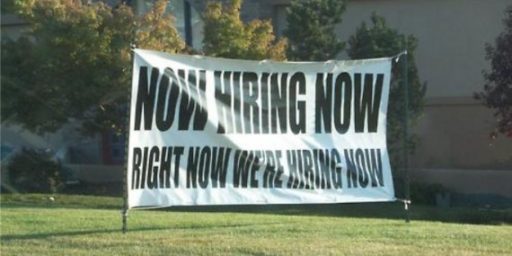Full Employment
At his eponymous blog, Daniel Gross writes,
Full employment? Has he read the most recent jobs report from the Bureau of Labor Statistics? The employment-population ratio is 62.8 percent, lower than it was for all of the second half of the 1990s. This is not what full employment looks like.
Well maybe. The problem is what is meant by full employment. It is not some set number. Some lay people might think it is where the unemployment rate is zero. Others might think it is some really low number. To economists the notion of full employment is where unemployment is at the Non-Accelerating Inflation Rate of Unemployment (NAIRU for short). That is, where unemployment is just at the rate where if unemployment goes any lower the inflation rate will start to accelerate.
The problem is that the NAIRU is not some fixed number, either. It depends on the current situtation in the economy. So to say that just because the employment situation is different now than it was during the second half of the 1990’s is not exactly the way to go about it.
The second link (to a post by Brad DeLong) Gross provides does go about demonstrating why things are probably not at full employment. However, Brad’s post does more than simply look at the employment-population ratio. It also looks at the trend, and looks at two other series as well. In short, it is not sufficient to look at the past and say it is not as good. DeLong writes,
One way to gain more information about what is “trend” and what is “cycle” is to take a look at other time series indicators that we believe have a similar cyclical component. When the labor market is cyclically strong, we believe that the unemployment rate will be lower than trend, that the employment-to-population ratio will be higher than trend, that average hours worked will be relatively high (since firms are likely to increase both bodies and hours when their demand for labor is strong), and that the average duration of unemployment will be relatively low (because more of the fluctuations in quits, firings, and hires that drive the employment side of the business cycle are on the hires side).
Generally, though things haven’t been good for the employment situation, IMO. Typically, the payroll survey from the Bureau of Labor Statistics has been spotty at best in terms of job gains. And while the unemployment rate didn’t go up all the much by historical standards during the last recession, there also seems to have been no sudden drop in unemployment at the end of the recession either. The trumpeting of the periodic good payroll numbers and the total number of jobs added to the payroll data is really nothing to be excited about. By historical standards it has been fairly weak.




One thing that isn’t covered by a lot of the employment stat-mangling is the increasing number of people who are self-employed, or working as contractors for other companies.
For example, in the hospitality industry you have a lot of folks who work as independent contractors or freelancers. The jobs range from on-call janitors to banquet servers to high-end technical support. The money can be really, really good, but according to most of the numbers these people aren’t “employed” in the normal sense. They also don’t show up on many of the other categories because they’re not incorporated.
You also have whole industries that are based on non-“employed” staff, such as Web design or computer consulting.
This also affects a certain segment of “wages,” since there are folks (like me) who make a certain amount through “regular” work for a half-dozen different companies, while doing a big chunk of business as “self-employed.”
cirby — I think if you looked at the BLS explanations of how the various employment data are constructed you would find that the official employment data does a pretty good job of caputuring the trends you are discussing.
If you are looking for employment holes, it would be good to understand why black youth unemployment is so high (26.6% for black youth 18-25), despite low general unemployment.
spencer-
I’ve looked at this sort of thing before, and sat in rooms with folks who do a lot of the analyzing, and I’m sure that they don’t, with any degree of completeness.
Sure, they make a few nods at including self-employed folks, but a lot of that is based on official stats based on things like incorporation and tax reporting. Since there’s more and more of a trend for individual businesses that aren’t documented this way, they’re missing a large portion of the target population.